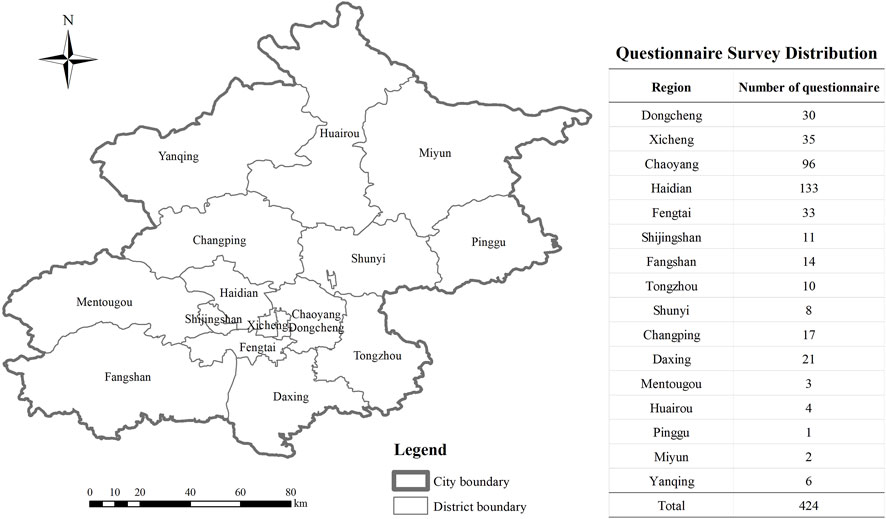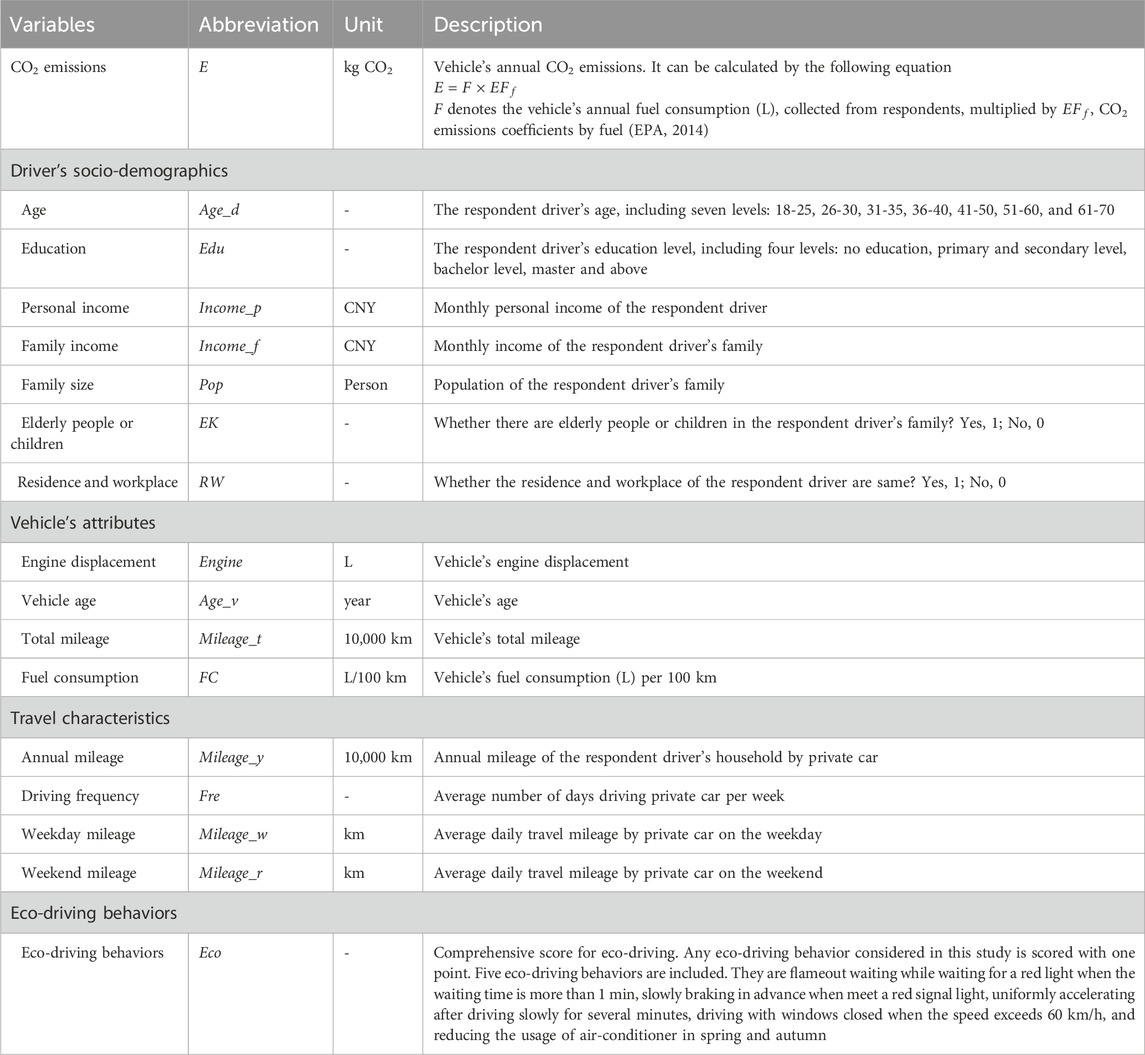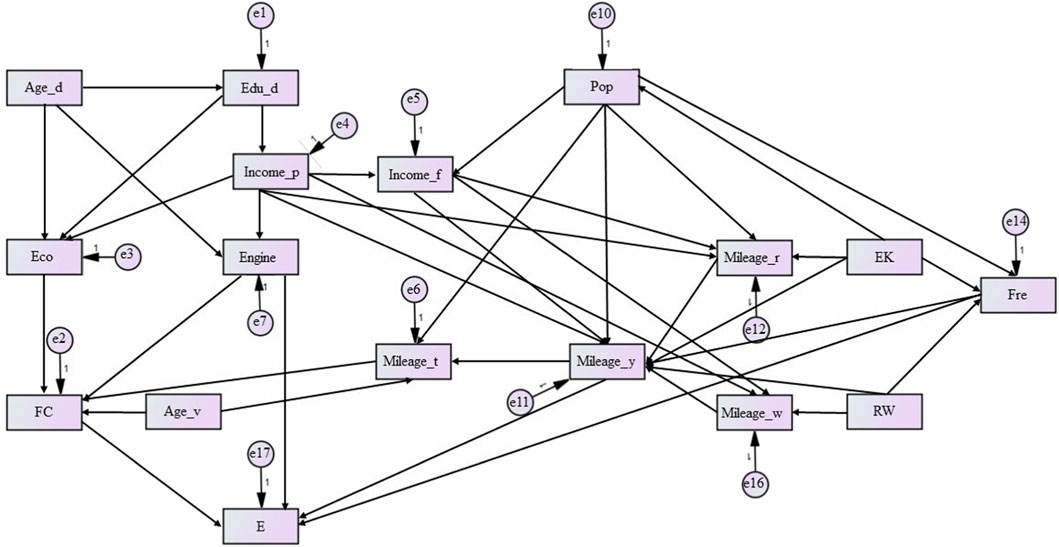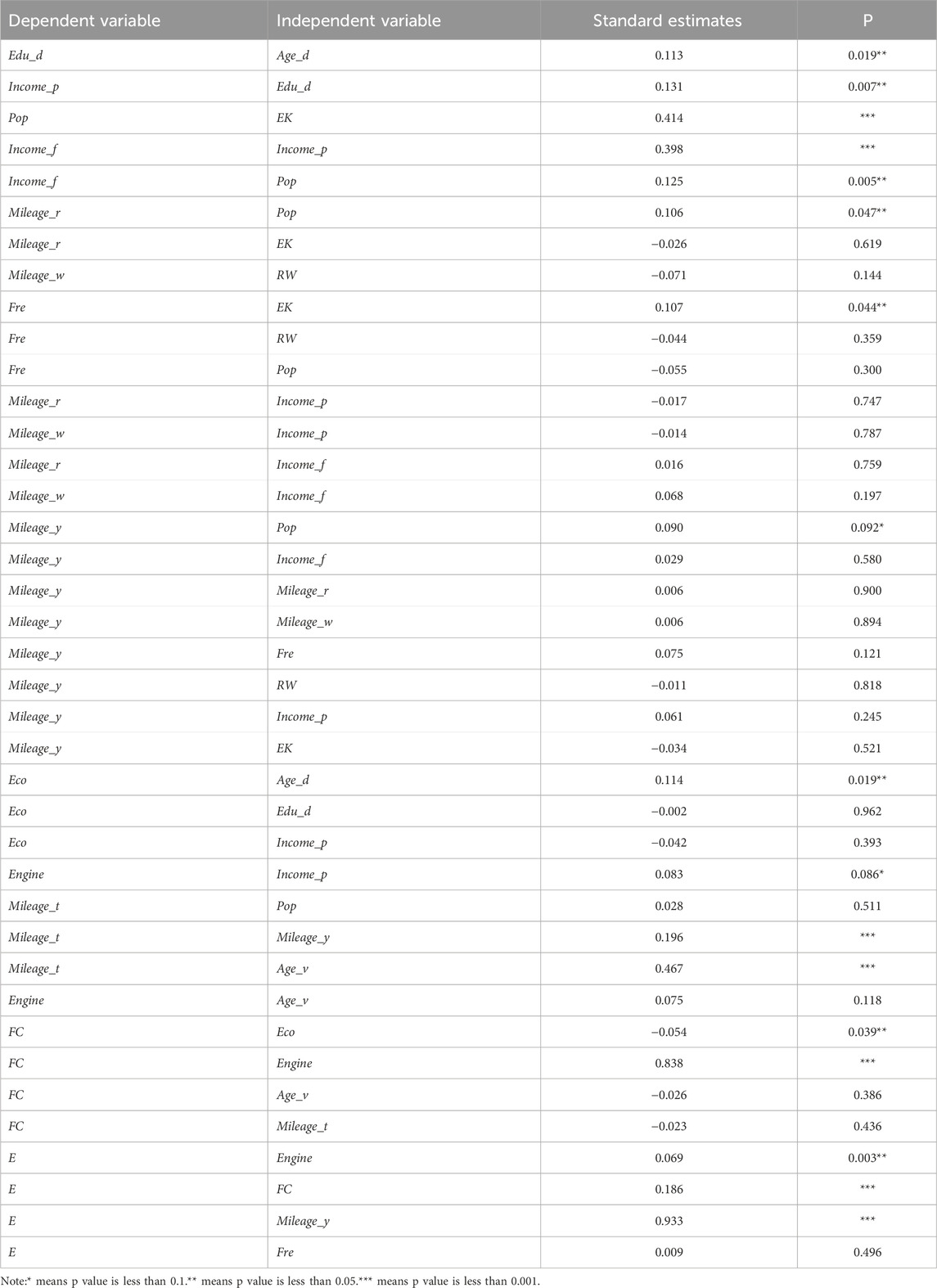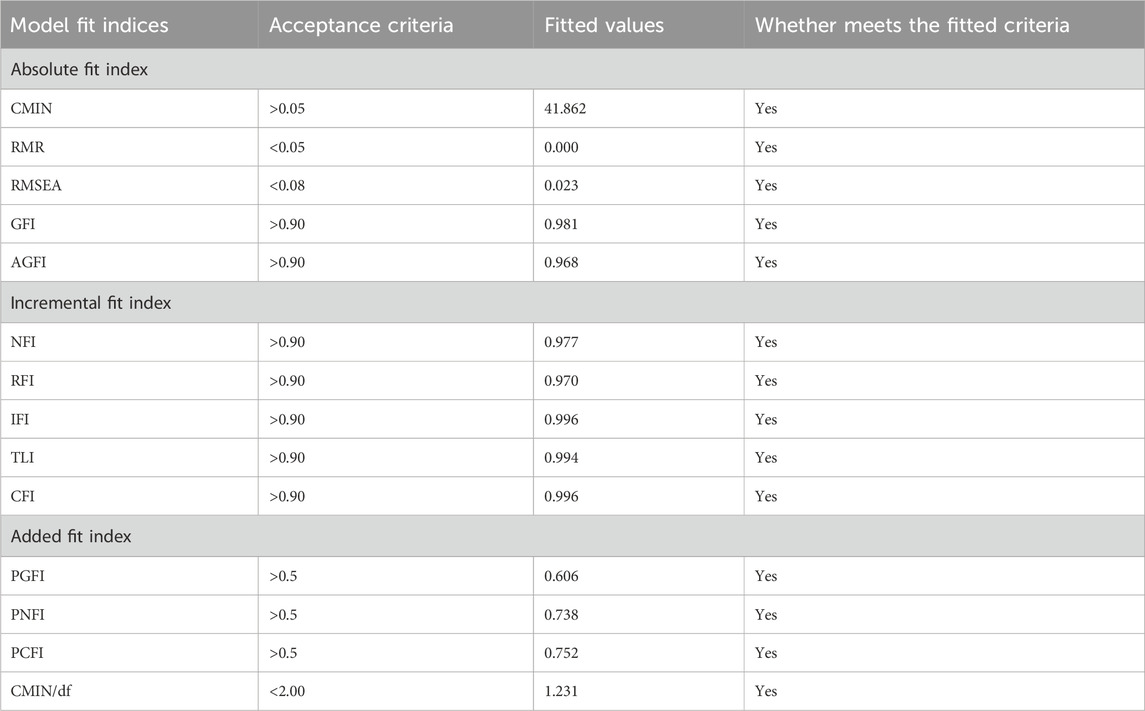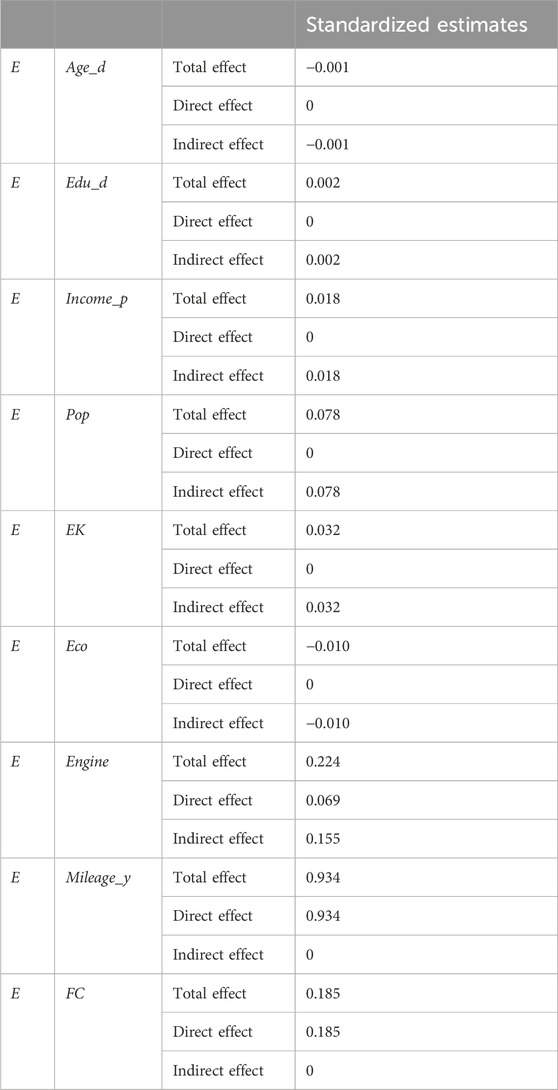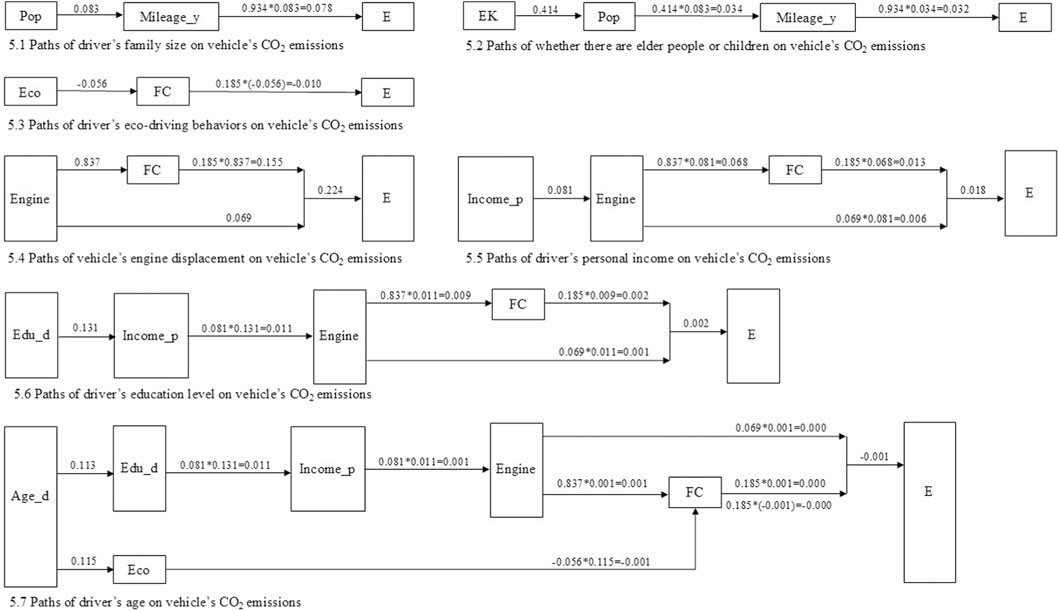- 1Institute of Geographic Sciences and Natural Resources Research, Chinese Academy of Sciences, Beijing, China
- 2Department of Urban Planning and Design, The University of Hong Kong, Pokfulam, Hong Kong SAR, China
How to reduce CO2 emissions from private vehicles with low efficiency and excessive growth is a global challenge for big cities. This study conducted a questionnaire survey for private cars in Beijing in 2019 and developed a path analysis model to uncover the influencing mechanisms of vehicle attributes and driver socio-demographics, travel patterns, and driving behaviors on private car CO2 emissions. The results show that fuel consumption per 100 km (FC), engine displacement (Engine), and annual mileage (Mileage_y) have a positive direct effect on CO2 emissions (E). Driver’s characteristics, including age (Age_d), education level (Edu_d), monthly personal income (Income_p), family size (Pop), whether there are elderly people or children in the family (EK), and eco-driving behaviors (Eco) influence E completely indirectly. The total influence in absolute value is, in order, Mileage_y (0.934) > Engine (0.224) > FC (0.185) > Pop (0.078) > EK (0.032) > Income_p (0.018) > Eco (−0.010) > Edu_d (0.002) > Age_d (−0.001). Higher income and education levels are associated with higher emissions, warranting targeted policy interventions for carbon mitigation.
1 Introduction
It is acknowledged that the transport sector, accounting for 23% of global energy-related CO2 emissions (IEA, 2020), is vital for achieving carbon neutrality. With the rising demand for automobile ownership and utilization, the carbon emissions of China’s transport sector are significantly increasing and possess substantial growth potential (Wu et al., 2016; Zhang et al., 2021). From 2000 to 2022, private vehicle ownership expanded rapidly and continuously from 6.25 million to 277.92 million, with an average annual growth rate of 18.8%. Numerous scholars claim that private vehicles play a crucial role in CO2 mitigation due to their low efficiency and excessive growth (Xu and Lin, 2016; Zhang et al., 2017; Liu et al., 2025). Therefore, it is critical to develop and implement rational and practical policies to reduce CO2 emissions from private vehicles.
Beijing, with a population of 21.85 million and an area of 16,410.54 km2, is the capital and largest city in northern China. As a low-carbon city pilot, Beijing is an important and representative case. It also links to a broader global issue concerning strategies to reduce carbon emissions in big cities, particularly in developing countries (Kelly and Zhu, 2016). As illustrated in Figure 1, the private vehicle ownership in Beiujing has exhibited a consistent increasing trend, reaching 5.87 million in 2022. Given the substantial existing private vehicle fleet, relying solely on macro-level policy measures is insufficient to achieve timely and effective carbon mitigation. It is essential to incorporate micro-level, short-term interventions - such as individual behavioral decisions - to complement macro-level strategies, thereby facilitating both immediate and sustained progress toward carbon neutrality. Consequently, examining the determinants and pathways influencing private car CO2 emissions in Beijing from an individual car-use perspective is of critical importance.
Many studies have explored the influencing factors, such as population, economic level and structure, energy intensity and structure, transportation intensity, freight turnover, and technology status, of CO2 emissions in the transport sector from a macroscopic perspective, including country (Liu et al., 2021), regional (Guo and Meng, 2019; Li, 2019), provincial (Cao et al., 2024; Li et al., 2022; Peng et al., 2020; Yang et al., 2019), and city levels (Wan et al., 2025; Wang and Liu, 2015). Taking China as an example, Liu et al. (2021) analyzed the influencing factors of carbon emissions in the transport sector based on the Log Mean Divisa Index (LMDI) approach, and found that capital investment, energy structure, and labor input increased carbon emissions, while technology advancement, energy intensity, transportation intensity, and energy emission intensity inhibited carbon emissions. Li et al. (2022) examined the carbon emissions of transportation sector across 30 Chinese provinces from 2005 to 2019. The results indicated that the inhibitory effects of energy efficiency and urbanization are less than the promoting effects of income growth, private vehicle ownership, and cargo turnover. Wan et al. (2025) selected six Chinese cities as case and investigated the driving factors of urban transportation carbon emissions by using LMDI and found that the primary drivers vary among different types of cities.
Although macroscopic research on the influencing factors of transportation CO2 emissions have provided strong scientific support for the formulation of long-term macroscopic carbon reduction policies in the transportation sector, due to data limitations, studies focusing on the influencing factors and underlying mechanisms from a microscopic individual perspective remain insufficient. The studies exploring the influencing factors and pathways of transportation carbon emissions from a microscopic perspective are summarized in Table 1. Using Beijing as a case, Liu et al. (2017) investigated the impacts of neighborhood-scale built environment factors on the reduction of travel-related CO2 emissions and found that higher land use mix, better public transit accessibility, and more pedestrian-friendly street design make residents tend to emit less CO2 in daily travel. Ma et al. (2015) examined the influences of built environment at both neighborhood and city scales on travel behaviors and subsequent CO2 emissions by work and non-work trips. Xu et al. (2018) explored influencing factors across built environment, socio-demographics, and travel attitudes in Xiamen, China. The results suggest that many indicators interactively influence travel carbon emissions. Yang and Cao (2018) conducted a travel survey in Guangzhou, China, by trip purposes, and explored the effects of the neighborhood-built environment on travel-related CO2 emissions. Based on data from the National Travel Survey of the United Kingdom, Cerqueira et al. (2020) investigated the impacts of socio-economic characteristics and the diversification of workplaces on travel behavior and CO2 emissions through a path analysis approach at the individual scale. Combining travel survey and regression model, Yang et al. (2018) estimated the individual daily travel carbon emissions in Beijing and investigated the individual, household, and living environment characteristics of high emitters. The results showed that high emitters are residents who rely more intensively on car usage.
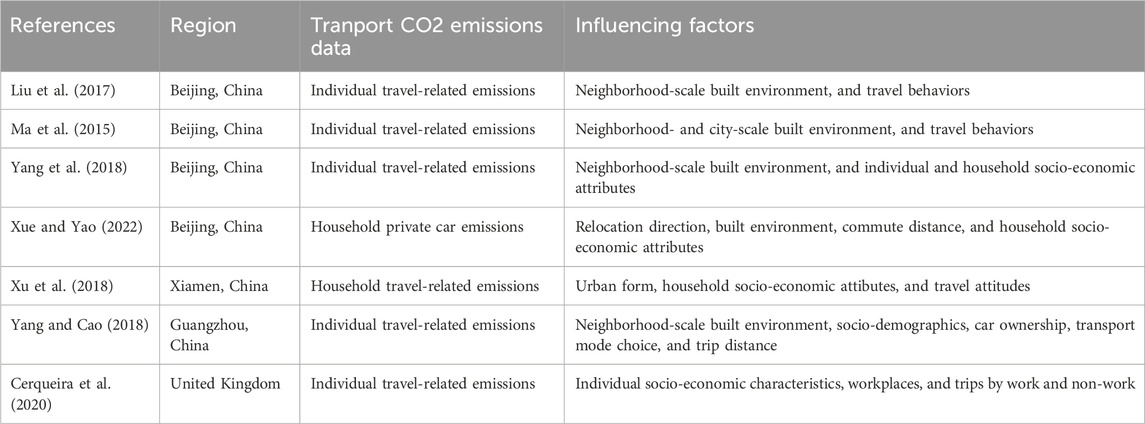
Table 1. Studies of the influencing factor and mechanisms of transportation CO2 emissions from a microscopic perspective.
Even though existing research has found that private cars are the leading source with the greatest potential to travel-related carbon emissions (Wang and Liu, 2015) and are crucial for energy saving and carbon reduction (Chen and Lei, 2017; Korkmaz et al., 2021; Long et al., 2020), current studies predominantly concentrated on travel-related CO2 emissions rather than those from private cars. Many studies suggest that socio-demographic factors such as household size, income, education, employment, age, etc., may influence residents’ travel behavior and emissions (Cerqueira et al., 2020; Chung and Wu, 2020; Xu et al., 2018), but the effects of drivers’ socio-demographic characteristics on carbon emissions from private cars have not been well explored. Identifying the key determinants and understanding the influencing mechanisms of private car CO2 emissions from an individual car-use perspective are significant for targeting high emitters and proposing effective mitigation measures. Only Xue and Yao (2022) addressed the influences of relocation directions, living environment, commute distance, and socio-economic characteristics on household private car CO2 emissions before and after changing residential locations by establishing a SEM (Structural Equation Model). The results indicate that commuting distance, private car purchases, family size, electric bicycles, and public smart cards influence emissions directly, while relocation, built environment, home size, and adolescent number in the family influence emissions indirectly.
Since vehicle CO2 emissions are closely linked to fuel consumption (Gao et al., 2024; Li et al., 2017), this paper summarizes influencing factors and pathways of vehicle fuel consumption. Zhou et al. (2016) systematically reviewed the factors affecting vehicle fuel economy and categorized them into six groups: vehicle-, roadway-, travel-, weather-, and traffic-related factors. However, their review was conducted from a vehicle-based perspective rather than an individual car-use perspective, which could support the development and implementation of micro-level, short-term measures to reduce private vehicle CO2 emissions. Eco-driving is an immediate, low-cost intervention that can significantly reduce fuel consumption (Allison and Stanton, 2019; Huang et al., 2018). Based on field trial data from 1,156 trips involving two vehicles and 24 drivers, Lois et al. (2019) constructed a path analysis model to examine the short-term impacts of eco-driving on fuel consumption considering real traffic conditions, including road characteristics (fixed factors) and traffic congestion (flexible factors). The results show that fuel savings by eco-driving are significant and vary widely (3.86%–9.26%) depending on vehicle type and city. However, the field trial involved only two vehicles, which may introduce bias to the results.
To address the deficiencies in examining the determinants of transportation CO2 emissions at an individual level, with a particular focus on private car use, and an analysis of multiple factors considering the interactions among influencing factors, this study proposes two research questions: (1) What factors have a significant impact on private car CO2 emissions? (2) How do these factors impact emissions and through what pathways? (3) What are the characteristics of high-emission groups? By constructing a path analysis model involving the interactions among multiple influencing factors, this study examined the impacts of drivers’ socio-demographics, vehicle preferences and usage, and driving habits on private car CO2 emissions. The innovation and contribution of this study are twofold. First, it provides a novel perspective by focusing on private car CO2 emissions from the micro-level of individual car use. Compared with existing studies that primarily emphasize travel-related emissions at an aggregate level, this study integrates multiple dimensions, including vehicle attributes, driver behaviors, household travel patterns, and driver’s socio-demographic characteristics, to comprehensively investigate their direct and indirect impacts on CO2 emissions. Furthermore, it considers the interrelationships among these factors, providing a more holistic understanding of the mechanisms at the individual level. Second, this study contributes to policymaking by offering evidence-based insights into how various personal and behavioral factors drive private car CO2 emissions. By identifying high-emitting vehicle-user profiles and their behavioral patterns, the findings can support the development of more targeted, refined, and practical emission reduction policies.
2 Methodology
2.1 Study area and data collection
The data utilized in this study were collected through questionnaires, combining online surveys and face-to-face interviews conducted in Beijing from December 1st to 31 December 2019. Participants provided confirmation and consent on the homepage of the online questionnaire prior to accessing the survey page. Similarly, the paper questionnaires for face-to-face surveys also included a confirmation and consent section at the beginning. Additionally, participants could discontinue the survey at any point during the process. The survey was randomly distributed across all 16 districts in Beijing (Figure 2). Given the focus on private car CO2 emissions, we selected respondents aged between 18 and 70 with more than 1 year of driving experience to ensure data quality. To validate the collected data, logic consistency checks, and cross-validation questions were incorporated. For example, if a respondent reported a household monthly income lower than their individual monthly income, the questionnaire was marked as invalid and excluded from analysis. Face-to-face interviews were conducted at automobile sales service shops and shopping malls. When the respondents fill in the questionnaire, the interviewers stay aside and provide necessary instructions. For the online survey, the Wenjuanxing platform (https://www.wjx.cn/) was employed for data collection. Prerequisite questions are set to guarantee that the respondents own vehicles and in Beijing. A total of 600 questionnaires were distributed, with all collected. The response rate is 100%. Due to missing data, 176 questionnaires were excluded from analysis. Ultimately, 424 questionnaires are valid. The effective response rate is 70.67%.
The questionnaire contains information on four aspects as following: (1) the driver’s socio-demographic characteristics, including age, education level, family size, personal income, household income, whether there are elderly people and children in the family, and whether residence and workplace are in the same district, etc.; (2) the vehicle’s attributes, including engine displacement, vehicle age, total mileage, and fuel consumption, etc.; (3) the private car travel information of the driver’s household, including annual mileage, average daily mileage on weekdays and weekends respectively; and (4) eco-driving behaviors, encompassing most energy-saving driving behaviors in the green driving training proposed by the Ministry of Transport of the People’s Republic of China (2010), such as braking mode, accelerating habits, and air-conditioning usage, etc. The definitions and descriptions of all variables in the model are shown in Table 2.
2.2 Path analysis and model modification
Path analysis, a specific form of Structural Equation Model (SEM), was developed by Sewall Wright (Wright, 1921; Wright, 1934) and can be used to infer anticipated causal relationships among factors (Chen and Lei, 2017). Therefore, this paper investigates the effects of driver’s socio-demographics, travel characteristics, driving behaviors, and vehicle attributes on CO2 emissions from private cars by establishing a path analysis model. Based on the theoretical analysis, the hypotheses of this research are proposed. The conceptual research framework is depicted in Figure 3. Existing research has shown that the driver’s socio-demographic characteristics affect vehicle selection preferences, travel distances, and travel-related CO2 emissions. Travel distance, engine displacement, and fuel economy are likely to have significant impacts on travel-related CO2 emissions. Additionally, these variables are likely to influence each other. For example, the driver’s family size and whether there are elderly people or children in the driver’s family are related. Family size would affect travel distance and frequency. Amos 28 is used in this study. In Amos 28 software, the observational variables are represented by rectangles. The error terms of variables are represented by circles. Arrows indicate causal relationship among variables, originating from the causal variables to outcome variables. The complete list of hypotheses is provided in the Supplementary Materials.
Hypotheses 1. The driver’s age will have a significant positive correlation with the driver’s eco-driving behaviours.
Hypotheses 2. The driver’s education level will have a significant positive correlation with the driver’s eco-driving behaviours.
…
Hypotheses 39. The driving frequency will have a significant positive correlation with the vehicle’s annual CO2 emissions.
Table 3 shows the path coefficients and significance of the conceptual model. Path analysis is conducted by removing the non-significant paths and estimating the residual coefficients using the standard regression path coefficients. P-values, indicating the significance of the path from independent to dependent variables, are used to select significant paths. Paths with p-value lower than 0.1 are considered statistically significant, while those with p-values higher than 0.1 are deemed non-significant and are removed. The framework and path coefficients of the adjusted model are shown in Figure 4 and Table 4.
3 Results and discussion
3.1 Goodness-of-fit
Table 5 shows the goodness-of-fit statistics for the adjusted model and the corresponding acceptance criteria values. All indicators meet the fitted criteria, indicating a good fit of the model.
3.2 Influencing factors and mechanisms of the private car’s CO2 emissions
The results of the decomposition of the path coefficients of the model are shown in Table 6. The total influence in absolute value is, in this order, Mileage_y (0.934) > Engine (0.224) > FC (0.185) > Pop (0.078) > EK (0.032) > Income_p (0.018) > Eco (−0.010) > Edu_d (0.002) > Age_d (−0.001). The vehicle’s fuel consumption per 100 km (FC) and annual mileage (Mileage_y) exibited only direct effects, with no indirect effects, on the vehicle’s CO2 emissions (E). It indicates that the impacts of FC and Mileage_y on E are not mediated by other variables. It is intuitive that these two variables, FC and Mileage_y, determine how much fuel is consumed and thus how much CO2 is emitted. The results of the intermediary effect analysis revealed that the influences of the driver’s age (Age_d), education level (Edu_d), monthly personal income (Income_p), family size (Pop), whether there are elderly people or children in the household (EK) and eco-driving behaviors (Eco) on E are full mediation with no direct influences, indicating that these influencing factors influence E completely through mediator. The influences of Edu_d, Income_p, Pop and EK on E are positive, while the influences of Age_d and Eco are negative. This indicates that the driver’s socio-demographic characteristics and driving habits affect emissions only by altering intermediate variables in the model, such as vehicle choice, usage behavior, or fuel consumption. The vehicle engine displacement (Engine) has both a direct (0.069) and an indirect positive effect (0.155), resulting in a total effect (0.224) on E. The direct and indirect components suggest that vehicle engine displacement contributes to CO2 emissions both directly through the vehicle’s inherent attributes and indirectly via associated fuel consumption patterns. Overall, these results underscore the importance of both vehicle-related and driver-related factors in shaping low-carbon private transportation. It emphasizes that interventions targeting only direct influencing factors (e.g. driving less or improving fuel efficiency) may be insufficient without considering upstream drivers like income, education, and driving habits, which influence emissions indirectly but substantially through the impact on vehicle choice and usage.
Figure 5 illustrates the influencing pathways of various factors on vehicle CO2 emissions. As shown in Figure 5.1, the driver’s family size (Pop) indirectly affects CO2 emissions (E) through the vehicle’s annual mileage (Mileage_y). An increase of one standard deviation in Pop results in a 0.083 standard deviation in Mileage_y, which increases E by 0.078 standard deviation. The results depicted in Figure 5.2 indicate that whether there are elderly people or children in the driver’s household (EK) indirectly influences E through Pop and Mileage_y. A one standard deviation increase in EK leads to a 0.414 standard deviation rise in Pop, causing a 0.034 standard deviation increase in Mileage_y, and subsequently a 0.032 standard deviation increase in E. Figure 5.3 demonstrates that the driver’s eco-driving behaviours (Eco) indirectly influence E through the fuel consumption per 100 km (FC). An increase of one standard deviation in Eco reduces FC by 0.056 standard deviation, resulting in a 0.010 standard deviation decrease in E. From Figure 5.4, the vehicle’s engine displacement (Engine) influences E both directly and indirectly via FC. A one standard deviation increases in Engine increase FC by 0.837 standard deviation, leading to a 0.155 standard deviation increase in E, with a direct effect of 0.069 standard deviation. Overall, a one standard deviation increase in Engine reaults in a total increase of 0.224 standard deviation in E, comprising direct (0.069) and indirect effects (0.155). Figure 5.5 shows that the driver’s personal income (Income_p) affects E through two indirect pathways. An increase of one standard deviation in Income_p raises Engine by 0.081 standard deviation, which further causes a 0.006 standard deviation increase in E directly and a 0.013 standard deviation increase indirectly through FC. As depicted in Figure 5.6, the driver’s education level (Edu_d) influences E through its effect on Income_p. A one standard deviation increase in Edu_d results in a 0.002 standard deviation increase in E. Figure 5.7 illustrates the influencing mechanisms of the driver’s age (Age_d) on E. An increase of one standard deviation in Age_d affects Edu_d and Eco by 0.113 and 0.115 standard deviations, respectively, leading to a 0.001 decrease in E.
3.3 Discussions
This study advances existing research on the influencing factors and underlying mechanisms of transportation carbon emissions at the microscopic level in two aspects. First, it adopts a novel individual car-use perspective to analyze private car CO2 emissions, going beyond traditional travel-based approaches that often combine various transport modes, making it difficult to isolate and analyze emissions from private vehicles. By integrating vehicle attributes, driver’s socio-demographics, travel characteristics, and driving habits into a path analysis model, this study reveals both the direct and indirect relationships among influencing factors. Second, the identification of high-emitting user profiles provides actionable insights for more targeted policy design, supporting more effective carbon reduction strategies in the private transportation sector.
Eco-driving, as individual vehicle usage behavior decisions including travel behavior and driving behavior, is a measure to improve fuel efficiency and reduce CO2 emissions (Lois et al., 2019). Previous studies indicate that eco-driving has the potential to save 5%–10% energy consumption (Caban et al., 2019). The results of this study show that eco-driving behaviors, limited to driving behavior decisions, can save 5.6% of the vehicle’s energy consumption per 100 km and reduce 1% of the vehicle’s CO2 emissions. Although a 1% reduction may seem modest at first glance, when aggregated across Beijing’s large and growing fleet of private vehicles, this reduction can lead to a significant impact on total transport-related emissions. As mentioned above, Beijing’s private vehicle ownership has increased continuously and is unlikely to decrease in the coming years. Additionally, it is not realistic for vehicle owners to completely give up private car use and switch to public transportation. In the short term, adopting eco-driving behaviors is an effective strategy to reduce CO2 emissions from private vehicles in Beijing. Eco-driving training is the most direct way to promote eco-driving (Wu et al., 2018). Such training can enhance drivers’ awareness of eco-driving practices, facilitate the integration of eco-driving into their daily driving routines, improve their eco-driving experience and proficiency, and ultimately form eco-driving habits that reduce carbon emissions. Although Beijing has implemented policies to encourage eco-driving behaviors, such as the publication of the Manual of Automobile Energy Saving Driving and the promotion of eco-driving benefits through social media, radio and print media, eco-driving has not been formally incorporated into driver training and licensing examinations. Therefore, considering both the demonstrated emissions reduction potential and the scalability of behavioral change across the driver population, eco-driving should be formally integrated as a mandatory module of the initial and renewal process for driver’s license.
The results of this study show that elderly drivers are more inclined to adopt eco-driving behaviors to save fuel costs and further achieve carbon reduction. For drivers sensitive to fuel costs, integrating the use of mobile apps that monitor driving behaviors and provide eco-driving tips, along with monetary incentives for consistent eco-driving practices, is recommended. For drivers less sensitive to fuel or monetary costs, eco-driving policies can be designed from the aspects of convenience, social recognition and intrinsic motivation. From a convenience perspective, implementing priority parking for eco-friendly drivers and carpoolers can reduce parking difficulties. Developing eco-driving certification programs that award drivers with recognition for environmentally conscious driving habits, coupled with public acknowledgement programs such as “Eco-Driver of the Month”, can promote eco-driving by enhancing drivers’ social recognition and intrinsic motivation.
This study finds that the utilization of low energy-consumption vehicles could reduce the carbon emissions associated with increasing automobile ownership to a certain extent. Klöckner et al. (2013) also find that individuals who feel unable to reduce car use but have the willingness to reduce emissions tend to purchase and use low-emission cars. Identifying key socio-demographic characteristics to target specific groups is crutial for policymakers when developing effective policy interventions. The results of this study indicate that individuals with higher income and education levels exhibit lower preferences for low energy-consumption vehicles. The Beijing government should pay more attention to higher income and education groups when formulating and implementing policies to promote the adoption of low-emission vehicles. Regarding the income and education levels, the current literature presents inconsistent findings. For example, Chng et al. (2019) conducted research on socio-demographic profiles during car purchase reflections, and found that, in the UK, women, older people, non-white ethnic groups, urban residents are more likely to consider purchasing low-emission vehicles, including small-engine or environment-friendly cars and electric vehicles, while wealthier and more educated residents are less prone to. Conversely, Sovacool et al. (2018) assessed preferences for electric vehicles across Denmark, Finland, Iceland, Norway, and Sweden, and concluded that men with higher education in full-time employment are most likely to select low-emission cars. The different preferences for low-emission cars among higher income and education groups are attributed to a combination of economic capability, lifestyle preferences, social status, and environmental issues awareness (Buhmann and Criado, 2023; Knez et al., 2014). In the context of China, individuals with higher income and education levels may possess greater economic capability to purchase more expensive, higher-performance vehicles, which are often associated with higher energy consumption and carbon emissions. For many in this group, car ownership is not only a practical need but also a symbol of social status and personal success. Consequently, preferences may lean toward vehicles that reflect affluence and prestige rather than energy-efficiency and low-emission, which are sometimes perceived as budget or utilitarian options. Furthermore, although environmental awareness is increasing in China, it may not yet be the primary factor influencing car purchase decisions among consumers with high income and educational levels. Instead, lifestyle preferences, brand reputation, and perceived comfort or driving experience may weigh more heavily in their choices. Beijing has implemented stringent vehicle purchase control policies, including participation of fuel vehicles in the license plate lottery system and prioritization of new-energy vehicles for license plates. Based on current policies, designing low emission zones in key areas of Beijing–permitting only small-engine and new-energy cars–is an approach to further promote the switch to low-emission transportation.
This study finds that family size has positive effects on annual mileage and further indirectly affects private car CO2 emissions positively. The standard coefficient of the total effect of family size on private car CO2 emissions is 0.078, significantly less than 1, meaning that the per capita private car CO2 emissions of larger families are lower. Larger families have more travel demands and shared mobility within the household, resulting in higher total CO2 emissions and lower per capita CO2 emissions. Xue and Yao (2022) observed similar positive effects of family size on private car CO2 emissions using the Fifth Travel Survey of Beijing Inhabitants and land use data. As shown in Figure 6, over the past 3 decades, the household size in Beijing has decreased continuously. The increase of small-size families may reduce opportunities for shared car travel within households, potentially leading to increased carbon emissions. Ridesharing, drivers share empty seats via mobile applications (Shaheen and Cohen, 2021), can improve vehicle occupancy, reduce car usage, and lower carbon emissions (Lazarus et al., 2021; Si et al., 2022). However, numerous barriers, including economic, technological, business, behavioral, and regulatory obstacles, prevent the development and widespread adoption of ridesharing (Mitropoulos et al., 2021). To address economic barriers, implementing a transparent billing system with clear cost-sharing rules and dynamic pricing based on market supply and demand is suggested to reduce disputes among passengers and drivers. From the perspective of technology, using advanced algorithms to optimize passenger-driver matching and employing AI for intelligent route planning can minimize unnecessary time costs and detours. To overcome business barriers, establishing comprehensive feedback mechanisms to promptly address issues raised by users is essential. Behavioral barriers can be mitigated by enhancing identity verification, implementing real-time trip monitoring, and providing emergency alarm buttons and rapid response systems to ensure safety for both passengers and drivers. Additionally, further refinement of ridesharing-related laws and regulations is necessary.
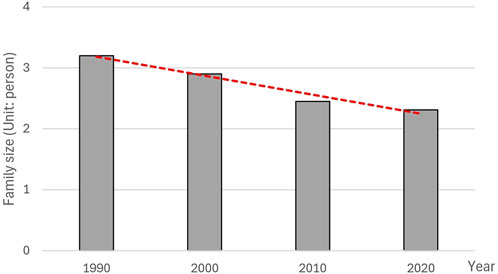
Figure 6. Family size of Beijing from 1990 to 2020. (Data source: The Fifth, Sixth and Seventh National Census).
This study extends the understanding of the factors and mechanisms influencing CO2 emissions from an individual driving perspective. However, this study has some limitations. First, this study does not take the driver’s pro-environmental attitudes into consideration. We only introduce the driver’s eco-driving behaviors into the research framework and identify groups with better eco-driving behaviors and lower carbon emissions. Eco-driving training is an important way to improve eco-driving behaviors by improving the drivers’ awareness and attitudes towards eco-driving. The relationships between drivers’ attitudes towards eco-driving and their actual eco-driving behaviors should be further explored in future research. Secondly, electric vehicles (EVs) are not analyzed in this study. EVs are expected to significantly reduce CO2 emissions from private vehicles, particularly when the electricity used is generated by low-carbon or zero-carbon sources (Chen et al., 2022; Choudhari et al., 2024). Due to the limited number of electric vehicles in Beijing in 2019, although the survey questionnaire was designed separately for fossil fuel vehicles and electric vehicles respectively, the sample size of electric vehicle data was insufficient for model analysis. Although the current penetration rate of EVs is still relatively low, support policies, technological advancements, and growing environmental awareness are expected to accelerate EV adoption, contributing to long-term emission reductions in the private transportation sector. Research on the influencing factors and mechanisms of the carbon footprint of EVs is also of great significance under rapid development of EVs. Finally, this study uses 2019 questionnaire data, providing a stable pre-pandemic baseline. Although China’s dual-carbon strategy began in 2021, the 2019 data remian relevant as many influencing factors, such as vehicle attributes, change gradually. Nonetheless, future research should update and expand the dataset to reflect recent developments and provide more targeted and timely policy recommendations.
4 Conclusion
Reducing CO2 emissions from private cars, characterized by low energy efficiency and continued growth, remains a significant challenge for large cities in developing countries like China. Understanding the mechanisms influencing private car CO2 emissions is an important prerequisite for achieving carbon neutrality. While macroscopic research on the investigation of influencing factors of CO2 emissions in the transportation sector have gained considerable attention, the microscopic studies of the underlying mechanisms of private car CO2 emissions at the individual scale are insufficient. Using survey data from Beijing and constructing a path analysis model, this study investigates the underlying mechanisms of CO2 emissions of private vehicles from an individual car-use perspective.
The vehicle’s fuel consumption per 100 km (FC), engine displacement (Engine) and annual mileage (Mileage_y) have a positive direct effect on the vehicle’s CO2 emissions (E). Annual mileage (Mileage_y) is the predominant factor. The driver’s socio-demographic characteristics, including age (Age_d), education level (Edu_d), monthly personal income (Income_p), family size (Pop), whether there are elderly people or children in the household (EK), and eco-driving behaviors (Eco) influence CO2 emissions (E) completely through mediators.
The vehicle’s engine displacement (Engine) has both direct and indirect positive effects on CO2 emissions (E). The total influence in absolute value is, in order, Mileage_y (0.934) > Engine (0.224) > FC (0.185) > Pop (0.078) > EK (0.032) > Income_p (0.018) > Eco (−0.010) > Edu_d (0.002) > Age_d (−0.001). The results show that vehicle usage and preference related factors, like vehicle annual mileage (Mileage_y), engine displacement (Engine), and fuel consumption per 100 km (FC), play an important role in emission reduction. However, strategies such as adjusting the current fleet structure (e.g., promoting the new energy vehicles and encouraging the purchase of low-emission vehicles) or reducing travel demand (e.g., alleviating working-living imbalance through urban planning) are long-term mitigation measures. Indirect effects through driver’s socio-demographic characteristics and driving habits are essential for short-term, behavior-based interventions. Socio-demographic factors, such as family size, income, education, age, etc., influence CO2 emissions indirectly by shaping vehicle choices, usage patterns, and driving behaviors. This study finds that higher income and education groups tend to own high-emission vehicles and exhibit less preference for low-carbon options, indicating the need for targeted incentives (e.g., differentiated vehicle purchases subsidies, personalized carbon footprint assessments) and more attention. In contrast, older individuals are more inclined to adopt eco-driving behaviors, suggesting that targeted training and promotional activities on eco-driving can be particularly effective for this group. Families with elderly members or children have higher total carbon emissions but lower per capita carbon emissions, highlighting the importance of family-oriented mobility planning or carpooling support from economic, technological, business, behavioral and regulatory aspects.
Data availability statement
The raw data supporting the conclusions of this article will be made available by the authors, without undue reservation.
Ethics statement
Ethical review and approval was not required for the study on human participants in accordance with the local legislation and institutional requirements. The participants provided their written informed consent to participate in this study.
Author contributions
JZ: Conceptualization, Data curation, Formal Analysis, Investigation, Methodology, Project administration, Software, Supervision, Validation, Visualization, Writing – original draft, Writing – review and editing.
Funding
The author(s) declare that no financial support was received for the research and/or publication of this article.
Acknowledgments
The author would like to express the sincere thanks to Prof. Suocheng Dong and Prof. Yu Li from the Institute of Geographic Science and Natural Resources Research, Chinese Academy of Sciences and Prof. Lijun Zhang from Minzu University of China for their support during the questionnaire survey of this study.
Conflict of interest
The author declares that the research was conducted in the absence of any commercial or financial relationships that could be construed as a potential conflict of interest.
Generative AI statement
The author(s) declare that no Generative AI was used in the creation of this manuscript.
Any alternative text (alt text) provided alongside figures in this article has been generated by Frontiers with the support of artificial intelligence and reasonable efforts have been made to ensure accuracy, including review by the authors wherever possible. If you identify any issues, please contact us.
Publisher’s note
All claims expressed in this article are solely those of the authors and do not necessarily represent those of their affiliated organizations, or those of the publisher, the editors and the reviewers. Any product that may be evaluated in this article, or claim that may be made by its manufacturer, is not guaranteed or endorsed by the publisher.
Supplementary material
The Supplementary Material for this article can be found online at: https://www.frontiersin.org/articles/10.3389/ffutr.2025.1604942/full#supplementary-material
References
Allison, C. K., and Stanton, N. A. (2019). Eco-driving: the role of feedback in reducing emissions from everyday driving behaviours. Theor. Iss. Ergon. Sci. 20 (2), 85–104. doi:10.1080/1463922x.2018.1484967
Buhmann, K. M., and Criado, J. R. (2023). Consumers' preferences for electric vehicles: the role of status and reputation. Environ. 114, 103530. doi:10.1016/j.trd.2022.103530
Caban, J., Vrábel, J., Šarkan, B., and Ignaciuk, P. (2019). About eco-driving, genesis, challenges and benefits, application possibilities. Transp. Res. Proc. 40, 1281–1288. doi:10.1016/j.trpro.2019.07.178
Cao, P. J., Liu, Z., Zhang, H., Yan, P. Y., and Qin, C. X. (2024). Household size and transport carbon emissions in China: direct, heterogeneity and mediating effects. Sci. Total Environ. 925, 171650. doi:10.1016/j.scitotenv.2024.171650
Cerqueira, E. D. V., Motte-Baumvol, B., Chevallier, L. B., and Bonin, O. (2020). Does working from home reduce CO2 emissions? An analysis of travel patterns as dictated by workplaces. Transport. Res. Part D-Transport. Environ. 83, 102338. doi:10.1016/j.trd.2020.102338
Chen, W. H., and Lei, Y. L. (2017). Analysis of the impact path on factors of China's energy-related CO2 emissions: a path analysis with latent variables. Environ. Sci. Pollut. Res. 24 (6), 5757–5772. doi:10.1007/s11356-016-8300-y
Chen, J. H., Wang, F., He, X. Y., Liang, X. Y., Huang, J. L., Zhang, S. J., et al. (2022). Emission mitigation potential from coordinated charging schemes for future private electric vehicles. Appl. Energy 308, 118385. doi:10.1016/j.apenergy.2021.118385
Chng, S., White, M. P., Abraham, C., and Skippon, S. (2019). Consideration of environmental factors in reflections on car purchases: attitudinal, behavioural and sociodemographic predictors among a large UK sample. J. Clean. Prod. 230, 927–936. doi:10.1016/j.jclepro.2019.05.179
Choudhari, T. P., Illahi, U., Al-Hosni, M., Caulfield, B., and O’Mahony, M. (2024). Decarbonising shared mobility: the potential of shared electric vehicles. Environ. 133, 104313. doi:10.1016/j.trd.2024.104313
Chung, Y.-S., and Wu, C.-H. (2020). Cross-state comparison of income and vehicle-ownership effects on household mobility. Transp. Res. Rec. 2674 (11), 813–826. doi:10.1177/0361198120947420
EPA (U.S. Environmental Protection Agency) (2014). Emission factors for greenhouse gas inventories. Available online at: https://www.epa.gov/sites/default/files/2015-07/documents/emission-factors_2014.pdf (Accessed on April 2nd, 2024).
Gao, C., Xu, J. L., Jia, M., and Sun, Z. H. (2024). Correlation between carbon emissions, fuel consumption of vehicles and speed limit on expressway. J. Traffic Transp. Eng.-Engl. Ed. 11 (4), 631–642. doi:10.1016/j.jtte.2023.02.007
Guo, M., and Meng, J. (2019). Exploring the driving factors of carbon dioxide emission from transport sector in beijing-tianjin-hebei region. J. Clean. Prod. 226, 692–705. doi:10.1016/j.jclepro.2019.04.095
Huang, Y., Ng, E. C. Y., Zhou, J. L., Surawski, N. C., Chan, E. F. C., and Hong, G. (2018). Eco-driving technology for sustainable road transport: a review. Renew. Sust. Energ. Rev. 93, 596–609. doi:10.1016/j.rser.2018.05.030
IEA (International Energy Agency) (2020). Global energy-related CO2 emissions by sector. Paris: IEA. Available online at: https://www.iea.org/data-and-statistics/charts/global-energy-related-co2-emissions-by-sector (Accessed on July 2nd, 2024).
Kelly, F. J., and Zhu, T. (2016). Transport solutions for cleaner air. Science 352 (6288), 934–936. doi:10.1126/science.aaf3420
Klöckner, C. A., Nayum, A., and Mehmetoglu, M. (2013). Positive and negative spillover effects from electric car purchase to car use. Transport. Res. Part D-Transport. Environ. 21, 32–38. doi:10.1016/j.trd.2013.02.007
Knez, M., Jereb, B., and Obrecht, M. (2014). Factors influencing the purchasing decisions of low emission cars: a study of Slovenia. Environ. 30, 53–61. doi:10.1016/j.trd.2014.05.007
Korkmaz, P., Schmid, D., and Fahl, U. (2021). Incorporating uncertainties towards a sustainable European energy system: a stochastic approach for decarbonization paths focusing on the transport sector. Energy Strateg. Rev. 38, 100707. doi:10.1016/j.esr.2021.100707
Lazarus, J. R., Caicedo, J. D., Bayen, A. M., and Shaheen, S. A. (2021). To pool or not to pool? Understanding opportunities, challenges, and equity considerations to expanding the market for pooling. Transp. Res. Pt. A-Policy Prac. 148, 199–222. doi:10.1016/j.tra.2020.10.007
Li, L. (2019). Structure and influencing factors of CO2 emissions from transport sector in three major metropolitan regions of China: estimation and decomposition. Transportation 46 (4), 1245–1269. doi:10.1007/s11116-017-9827-6
Li, Y., Zheng, J., Li, Z. H., Yuan, L., Yang, Y., and Li, F. J. (2017). Re-estimating CO2 emission factors for gasoline passenger cars adding driving behaviour characteristics – a case study of beijing. Energy Policy 102, 353–361. doi:10.1016/j.enpol.2016.12.051
Li, R. R., Li, L. J., and Wang, Q. (2022). The impact of energy efficiency on carbon emissions: evidence from the transportation sector in Chinese 30 provinces. Sust. Cities Soc. 82, 103880. doi:10.1016/j.scs.2022.103880
Liu, Z. L., Ma, J., and Chai, Y. W. (2017). Neighborhood-scale urban form, travel behavior, and CO2 emissions in Beijing: implications for low-carbon urban planning. Urban Geogr. 38 (3), 381–400. doi:10.1080/02723638.2016.1191796
Liu, M. Z., Zhang, X. X., Zhang, M. Y., Feng, Y. Q., Liu, Y. J., Wen, J. X., et al. (2021). Influencing factors of carbon emissions in transportation industry based on C-D function and LMDI decomposition model: china as an example. Environ. Impact Assess. Rev. 90, 106623. doi:10.1016/j.eiar.2021.106623
Liu, C. X., Xiao, Z., Long, C., Wang, D., Li, T., and Jiang, H. B. (2025). MVCAR: Multi-view Collaborative Graph Network for private car carbon emission prediction. IEEE Transaction Intelligent Transp. Syst. 26 (1), 472–483. doi:10.1109/tits.2024.3488187
Lois, D., Wang, Y., Boggio-Marzet, A., and Monzon, A. (2019). Multivariate analysis of fuel consumption related to eco-driving: interaction of driving patterns and external factors. Transp. Res. Part D Transp. Environ. 72, 232–242. doi:10.1016/j.trd.2019.05.001
Long, Y., Huang, D., Lei, T., Zhang, H., Wang, D., and Yoshida, Y. (2020). Spatiotemporal variation and determinants of carbon emissions generated by household private car. Environ. 87, 102490. doi:10.1016/j.trd.2020.102490
Ma, J., Liu, Z. L., and Chai, Y. W. (2015). The impact of urban form on CO2 emission from work and non-work trips: the case of Beijing, China. Habitat Int. 47, 1–10. doi:10.1016/j.habitatint.2014.12.007
Ministry of Transport of the People's Republic of China (2010). The Ministry of Transport distributes Car energy-saving driving manual to promote green driving. Available online at: https://www.gov.cn/gzdt/2010-06/13/content_1627076.htm (Accessed on April 2nd, 2024).
Mitropoulos, L., Kortsari, A., and Ayfantopoulou, G. (2021). A systematic literature review of ride-sharing platforms, user factors and barriers. Eur. Transp. Res. Rev. 13 (1), 61. doi:10.1186/s12544-021-00522-1
Peng, Z. M., Wu, Q. Q., Wang, D. F., and Li, M. (2020). Temporal-spatial pattern and influencing factors of China's province-level transport sector carbon emissions efficiency. Pol. J. Environ. Stud. 29 (1), 233–247. doi:10.15244/pjoes/102372
Shaheen, S., and Cohen, A. (2021). “Shared mobility: an overview of definitions, Current practices, and its relationship to mobility on demand and mobility as a service,” in International encyclopedia of transportation. Editor R. Vickerman (Oxford: Elsevier), 155–159.
Si, H., Duan, X., Cheng, L., and Zhang, Z. (2022). Determinants of consumers’ continuance intention to use dynamic ride-sharing services. Environ. 104, 103201. doi:10.1016/j.trd.2022.103201
Sovacool, B. K., Kester, J., Noel, L., and de Rubens, G. Z. (2018). The demographics of decarbonizing transport: the influence of gender, education, occupation, age, and household size on electric mobility preferences in the Nordic region. Glob. Environ. Change-Human Policy Dimens. 52, 86–100. doi:10.1016/j.gloenvcha.2018.06.008
Wan, J. J., Wu, X., Li, Y. Y., Li, Z. L., Deng, K. H., Zeng, J. Q., et al. (2025). Driving factors and interactions of urban transportation carbon emissions: a case study of China. Environ. 143, 104740. doi:10.1016/j.trd.2025.104740
Wang, Z., and Liu, W. (2015). Determinants of CO2 emissions from household daily travel in Beijing, China: individual travel characteristic perspectives. Appl. Energy 158, 292–299. doi:10.1016/j.apenergy.2015.08.065
Wright, S. (1934). The method of path coefficients. Ann. Math. Statistics 5 (3), 161–215. doi:10.1214/aoms/1177732676
Wu, N., Zhao, S., and Zhang, Q. (2016). A study on the determinants of private car ownership in China: findings from the panel data. Transp. Res. Pt. A-Policy Prac. 85, 186–195. doi:10.1016/j.tra.2016.01.012
Wu, Y., Zhao, X., Rong, J., and Zhang, Y. (2018). The effectiveness of eco-driving training for male professional and non-professional drivers. Environ. 59, 121–133. doi:10.1016/j.trd.2018.01.002
Xu, B., and Lin, B. (2016). Differences in regional emissions in China's transport sector: determinants and reduction strategies. Energy 95, 459–470. doi:10.1016/j.energy.2015.12.016
Xu, L. L., Cui, S. H., Tang, J. X., Yan, X. M., Huang, W., and Lv, H. (2018). Investigating the comparative roles of multi-source factors influencing urban residents' transportation greenhouse gas emissions. Sci. Total Environ. 644, 1336–1345. doi:10.1016/j.scitotenv.2018.07.072
Xue, F., and Yao, E. (2022). Impact analysis of residential relocation on ownership, usage, and carbon-dioxide emissions of private cars. Energy 252, 124110. doi:10.1016/j.energy.2022.124110
Yang, W. Y., and Cao, X. S. (2018). Examining the effects of the neighborhood built environment on CO2 emissions from different residential trip purposes: a case study in Guangzhou, China. Cities 81, 24–34. doi:10.1016/j.cities.2018.03.009
Yang, Y., Wang, C., and Liu, W. (2018). Urban daily travel carbon emissions accounting and mitigation potential analysis using surveyed individual data. J. Clean. Prod. 192, 821–834. doi:10.1016/j.jclepro.2018.05.025
Yang, W., Wang, W., and Ouyang, S. (2019). The influencing factors and spatial spillover effects of CO2 emissions from transportation in China. Sci. Total Environ. 696, 133900. doi:10.1016/j.scitotenv.2019.133900
Zhang, Y. J., Liu, Z., Qin, C. X., and Tan, T. D. (2017). The direct and indirect CO2 rebound effect for private cars in China. Energy Policy 100, 149–161. doi:10.1016/j.enpol.2016.10.010
Zhang, M., Liu, X., and Ding, Y. (2021). Assessing the influence of urban transportation infrastructure construction on haze pollution in China: a case study of beijing-tianjin-hebei region. Environ. Impact Assess. Rev. 87, 106547. doi:10.1016/j.eiar.2020.106547
Keywords: carbon emissions, private vehicle, influencing mechanism, path analysis, individual perspective
Citation: Zheng J (2025) Pathway analysis of private car CO2 emissions: an individual car-use perspective. Front. Future Transp. 6:1604942. doi: 10.3389/ffutr.2025.1604942
Received: 07 May 2025; Accepted: 11 August 2025;
Published: 19 September 2025.
Edited by:
Salvador García-Ayllón Veintimilla, Polytechnic University of Cartagena, SpainReviewed by:
Zhu Xiao, Hunan University, ChinaShuqin Zhao, Henan University of Animal Husbandry and Economy, China
Xuezong Tao, Shanghai Maritime University, China
Copyright © 2025 Zheng. This is an open-access article distributed under the terms of the Creative Commons Attribution License (CC BY). The use, distribution or reproduction in other forums is permitted, provided the original author(s) and the copyright owner(s) are credited and that the original publication in this journal is cited, in accordance with accepted academic practice. No use, distribution or reproduction is permitted which does not comply with these terms.
*Correspondence: Ji Zheng, emhlbmdqLjEzc0BpZ3NucnIuYWMuY24=
 Ji Zheng
Ji Zheng
